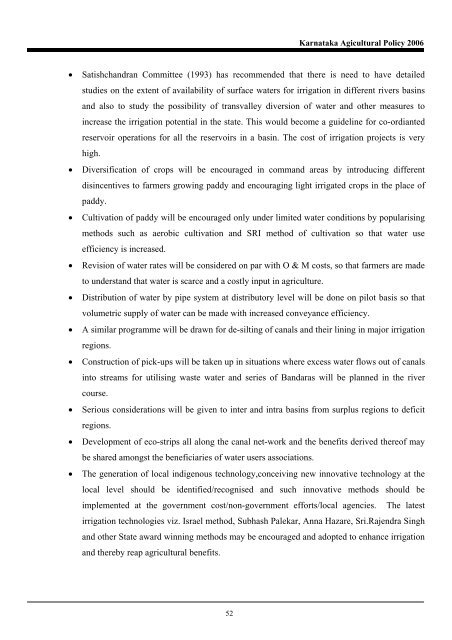Karnataka Agricultural Policy - Institute for Social and Economic ...
Karnataka Agricultural Policy - Institute for Social and Economic ...
Karnataka Agricultural Policy - Institute for Social and Economic ...
Create successful ePaper yourself
Turn your PDF publications into a flip-book with our unique Google optimized e-Paper software.
<strong>Karnataka</strong> Agicultural <strong>Policy</strong> 2006<br />
• Satishch<strong>and</strong>ran Committee (1993) has recommended that there is need to have detailed<br />
studies on the extent of availability of surface waters <strong>for</strong> irrigation in different rivers basins<br />
<strong>and</strong> also to study the possibility of transvalley diversion of water <strong>and</strong> other measures to<br />
increase the irrigation potential in the state. This would become a guideline <strong>for</strong> co-ordianted<br />
reservoir operations <strong>for</strong> all the reservoirs in a basin. The cost of irrigation projects is very<br />
high.<br />
• Diversification of crops will be encouraged in comm<strong>and</strong> areas by introducing different<br />
disincentives to farmers growing paddy <strong>and</strong> encouraging light irrigated crops in the place of<br />
paddy.<br />
• Cultivation of paddy will be encouraged only under limited water conditions by popularising<br />
methods such as aerobic cultivation <strong>and</strong> SRI method of cultivation so that water use<br />
efficiency is increased.<br />
• Revision of water rates will be considered on par with O & M costs, so that farmers are made<br />
to underst<strong>and</strong> that water is scarce <strong>and</strong> a costly input in agriculture.<br />
• Distribution of water by pipe system at distributory level will be done on pilot basis so that<br />
volumetric supply of water can be made with increased conveyance efficiency.<br />
• A similar programme will be drawn <strong>for</strong> de-silting of canals <strong>and</strong> their lining in major irrigation<br />
regions.<br />
• Construction of pick-ups will be taken up in situations where excess water flows out of canals<br />
into streams <strong>for</strong> utilising waste water <strong>and</strong> series of B<strong>and</strong>aras will be planned in the river<br />
course.<br />
• Serious considerations will be given to inter <strong>and</strong> intra basins from surplus regions to deficit<br />
regions.<br />
• Development of eco-strips all along the canal net-work <strong>and</strong> the benefits derived thereof may<br />
be shared amongst the beneficiaries of water users associations.<br />
• The generation of local indigenous technology,conceiving new innovative technology at the<br />
local level should be identified/recognised <strong>and</strong> such innovative methods should be<br />
implemented at the government cost/non-government ef<strong>for</strong>ts/local agencies. The latest<br />
irrigation technologies viz. Israel method, Subhash Palekar, Anna Hazare, Sri.Rajendra Singh<br />
<strong>and</strong> other State award winning methods may be encouraged <strong>and</strong> adopted to enhance irrigation<br />
<strong>and</strong> thereby reap agricultural benefits.<br />
52

















